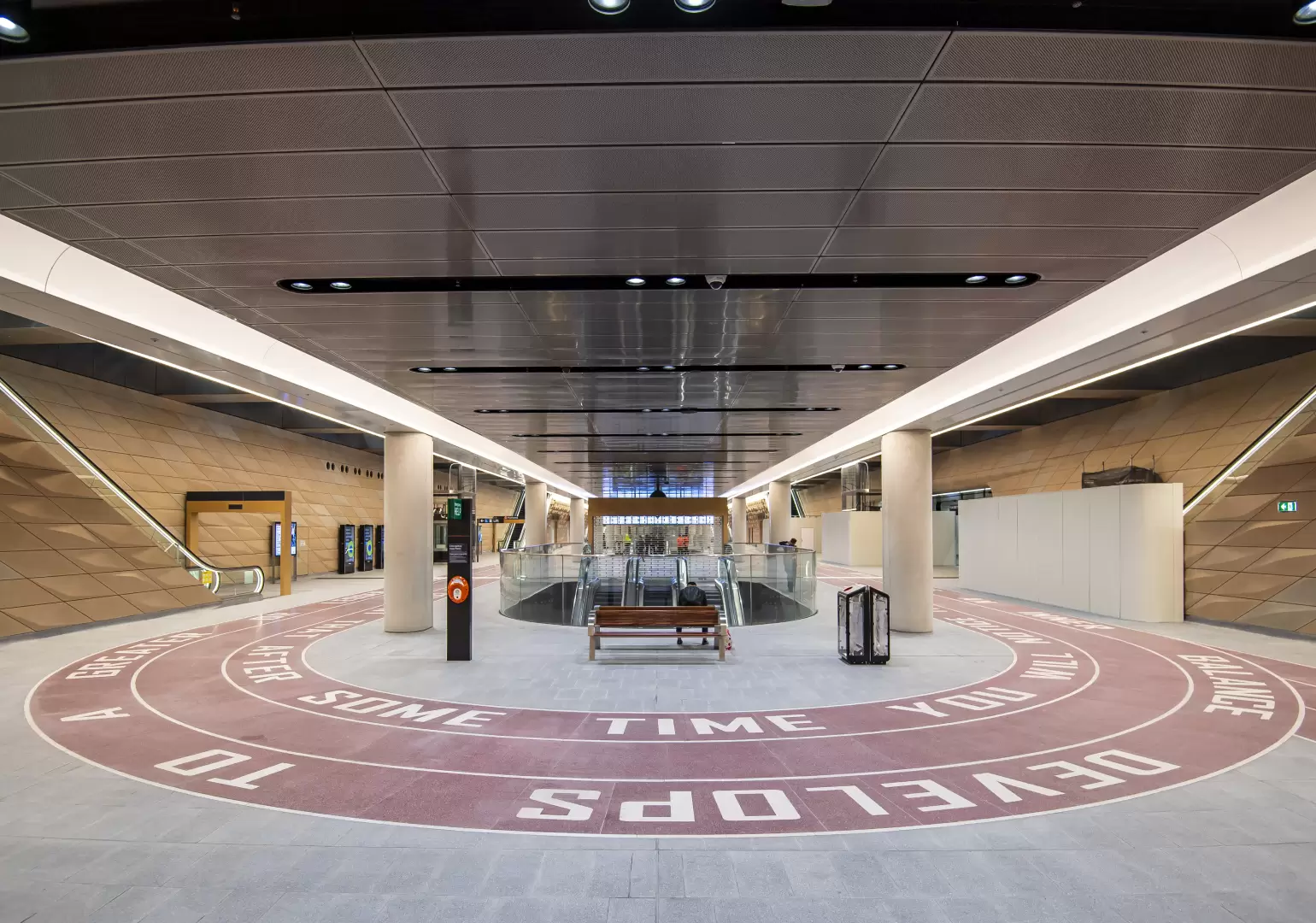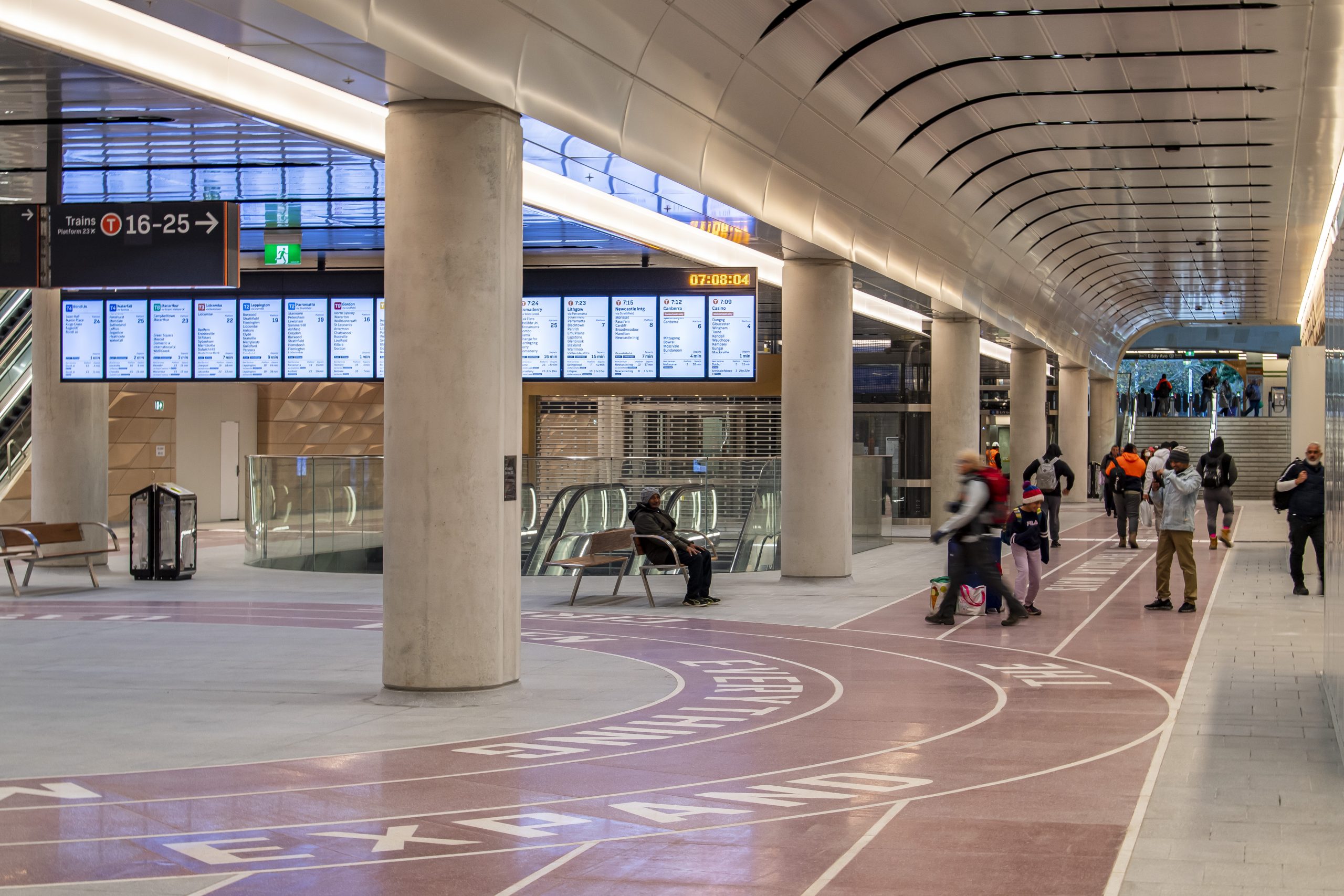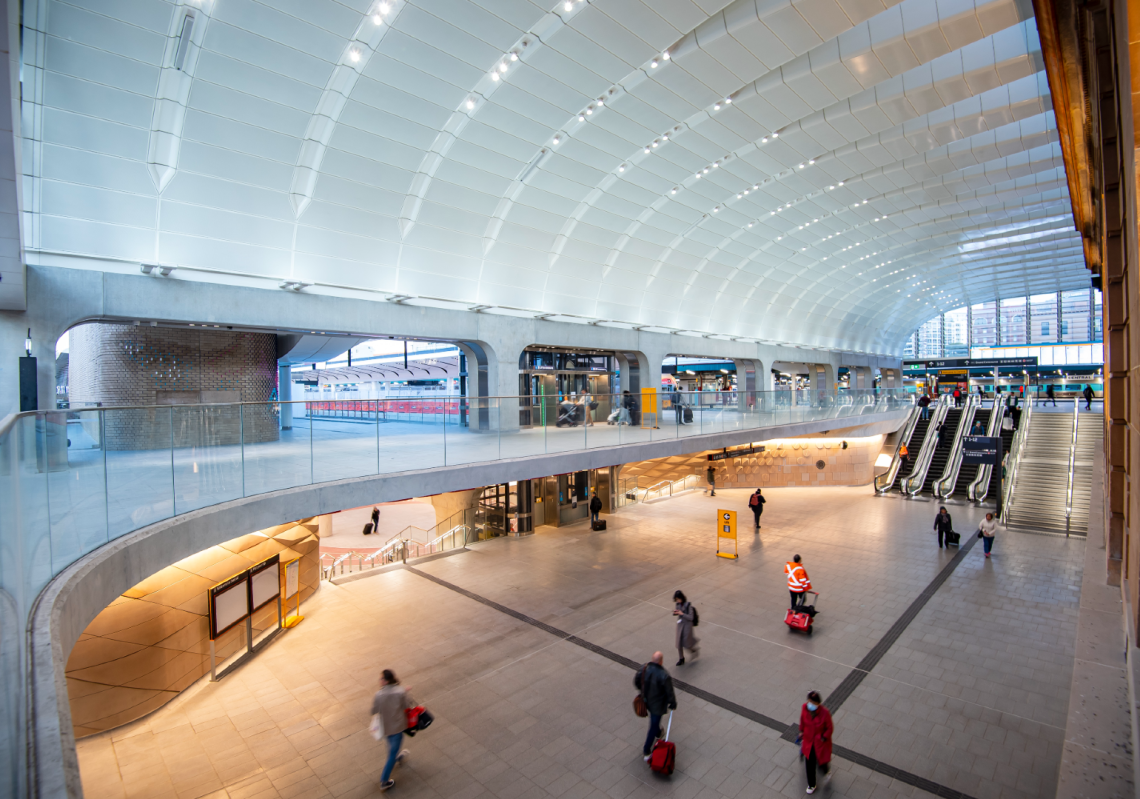Here’s how a team of engineers employed innovative design strategies to revitalise the nation’s busiest train station.
The mammoth Sydney Metro project is Australia’s largest urban rail infrastructure investment, encompassing four city-spanning metro lines, with 113 km in new rail lines across 46 stations.
As Australia’s busiest railway station, reviving Central Station – which the new Sydney Metro City & Southwest runs through – was an important part of the Metro project.
The heritage-listed station drew a line through inner Sydney back in 1874, separating Surry Hills from Ultimo, with the East-West Devonshire Street Tunnel providing the only thoroughfare.
In 2018, the NSW Government awarded Laing O’Rourke a $955 million contract to deliver the Sydney Metro platforms beneath existing platforms 13, 14 and 15, the new 19-metre wide Central Walk concourse from a new entrance on Chalmers Street, escalators directly to suburban platforms 16–23, and a revitalisation of the Grand and Northern Concourse entrance on Eddy Avenue.
Laing O’Rourke engaged the Joint Venture of Aurecon and GHD to deliver the design for all civil, structural, tunnelling and building services for the new and refurbished rail infrastructure.
The upgrade provided an opportunity to fix Central’s historical problems, said Tony Lavorato, Design Director at Aurecon.
“However, the intercity, light rail, pedestrian flow and suburban lines had to be kept operational during construction, which was a significant challenge,” Lavorato said.
The Aurecon/GHD team also had to work around historical buildings, a constrained inner-city site, and the aspirational brief to enhance the transit system in relation to its urban fabric and modern mobility – earning them a 2023 Engineers Australia Excellence Award.
“The station is over 100 years old, so there are a number of heritage buildings and legacy tunnels traversing the site,” said Amy Clark, Lead Structural Engineer at Aurecon. This includes the 120-year-old Devonshire Street pedestrian tunnel, which traverses the full width of the metro box, linking Surry Hills with Chippendale.
“The 230-metre-long subterranean metro box structure will link the existing intercity platforms at ground level with the new metro tunnels 27 m below ground,” she said.
Media error: Format(s) not supported or source(s) not found
Download File: https://createdigital.org.au/wp-content/uploads/2023/11/Sydney-Metro-roof-2_supplied.mp4?_=1Video: Sydney Metro
Top-down approach
With several site challenges, the team had to look beyond the reference design to differentiate their offering and provide a better, quicker and more efficient solution.
One of the key issues was accessing the site from the top level, where the intercity platform is located – with the only access point via the Sydney Yard Access Bridge.
“That meant that all materials could be moved in and out from one end of the site only, a bit like crafting a model ship inside a glass bottle,” Lavorato said.
Timing of the excavation of the metro box in relation to tunnelling works, conducted under a separate contract, posed another set of challenges.
“Contractually, [Laing O’Rourke] could not start building the metro box until the tunnel boring machine had gone through,” he said.
The back-of-house plant rooms also had to be handed over to the interface contractor in accordance with the line wide program.
With excavation unable to proceed beyond a reduced level (RL) of 3.655 m until tunnelling was completed, the delivery team employed a top-down construction approach.
“Laing O’Rourke took possession of two decommissioned intercity platforms,” Lavorato said. “At stage one, they installed temporary plunge columns and a piled retaining wall, before excavating and constructing a platform and track slab at the intercity level during stage two.”
Temporary holes in the intercity slab facilitated the removal of excavated earth and the delivery of materials and equipment to construct the levels below.
During stages three and four, which involved construction of the north-south concourse one level down, permanent inclined columns were erected with hydraulic jacks at their base. The jacks accommodated the transfer of load supported by the temporary plunge columns into the permanent inclined columns.
“When the struts were fully supported on the hydraulic jacks, those temporary columns could be removed,” Lavorato said. “Progress on the permanent structure could then commence without having to wait for the tunnel boring machine to complete its operation and be fully decommissioned.”
Most of the levels above the metro box were completed by stage five, meaning the critical back-of-house plant rooms could be handed over to the interface contractor on time.
The inclined columns were aligned to directly support the intercity platform, improving the structural efficiency of the concourse floor and opening the space.
“At the concourse level we shifted the columns in,” Lavorato said. “On either side of those columns, instead of having 4-metre ceilings, we were able to deliver 6.5-metre ceilings and locate skylights, so there was natural light at the main concourse level.”

Keeping the station running
As part of the Central Station Grand Concourse, the team designed a steel canopy roof, which is 40 m wide, 80 m long and 16 m high.
With the Grand Concourse acting as one of the interchange’s major arteries – facilitating the commute of 270,000 people every weekday – onsite daytime construction was not an option.
“We had to keep the concourse open so everyone could still navigate through the station and commuters weren’t delayed,” said Michael Chernyavsky, Associate Structural Engineer at Aurecon.
With trains not running from approximately 1:00 am until 5:00 am, a rapid on-site construction approach was adopted during overnight and, on occasion, weekend work periods.
“In the space of just a week, half of the canopy roof was constructed, which would normally take around six weeks if built traditionally,” he said. “Big segments weighing up to 9.2 tonnes were brought to site already prefabricated and prefinished with services and cladding installed.
“Connections were designed for simplicity and speed of installation, which enabled up to four panels to be installed in the 4-hour overnight window.”
Digital delivery
Digital delivery has advanced significantly since bidding the project, when global collaboration tools were not so commonplace. “This project was one of the very first in Australia to adopt BIM 360 to allow model sharing across the team’s global operations,” said Adam Favaloro, Digital Design Service Line Leader at GHD.
By adopting these tools early, the team could help advance what is possible in metadata management and model tracking and reporting via BIM track.
“Upskilling teams in common data environments paid dividends as COVID-19 hit, allowing the team to continue delivering designs, avoiding construction disruptions,” said Favaloro.

Ensuring sustainability
Along with overcoming difficult construction issues, the “triple bottom line” of environmental, economic, and social sustainability factors were key to the project’s design.
Preserving Central’s heritage buildings and legacy tunnels ensured its social value remains intact. However, a future focus was also required.
“From a design life perspective, a typical building is designed for 50 years,” Clark said. “This structure was designed for 120 years, which was a significant undertaking from a durability perspective.”
Bringing in natural lighting and improving sightlines for more intuitive wayfinding, particularly in the northern concourse, was another core focus.
“In the reference design, this intercity level protruded further out into the space, requiring a number of underlying columns,” Clark said. “Originally, the design felt enclosed and obstructed, making it difficult to navigate. Whereas our introduction of the cantilever, which extends 10 m from a single line of support, really opened up the space for the public.”
Environmentally speaking, the top-down construction approach reduced the embodied carbon of the metro box structure by 38 per cent through dematerialisation.
“We also used a high proportion of supplementary cementing materials in the concrete mixes, low carbon steel and alternative wall materials in the station box to reduce the embodied carbon,” said Damien Mulvanah, Senior Sustainability Consultant at GHD.
The use of glass fibre reinforced concrete for the façade cladding system instead of sandstone significantly reduced the thickness of the material required, without compromising the architectural intent. Recycled water, manufactured sand, and recycled aggregates were used in the concrete production, along with polymer injection technology in the manufacturing of reinforcing steel.
“Our overall design focused on reducing operational energy consumption through elements like high energy efficient cooling systems, efficient lighting technology and low consumption lifts and escalators, resulting in a 39 per cent reduction in operational electricity consumption,” Mulvanah said.
The project has been awarded a 6-star Green Star Design Review rating, and achieved a Leading Rating Level against the IS Rating, representing world leadership in sustainable building design.
Aside from the engineering feats accomplished by the team, seeing the social benefits that come with improved accessibility reaffirmed the contribution of the project to the community.
“A good mate of mine who’s visually impaired, now aided by a guide dog, recently shared with me, ‘With the new improvements to Central Station, I’m able to get around a lot easier’,” Lavorato explained. “He now travels to his office three days a week, which is something he really missed.”
The national Excellence Awards are to be announced in Melbourne on 29 November. Register for the Gala event here.




A fantastic project that stretched the boundaries of what is possible. We must recognise the individual and collective contributions of all engineers from the client, operator, contractor, design and trade partners in achieving such a fantastic outcome.